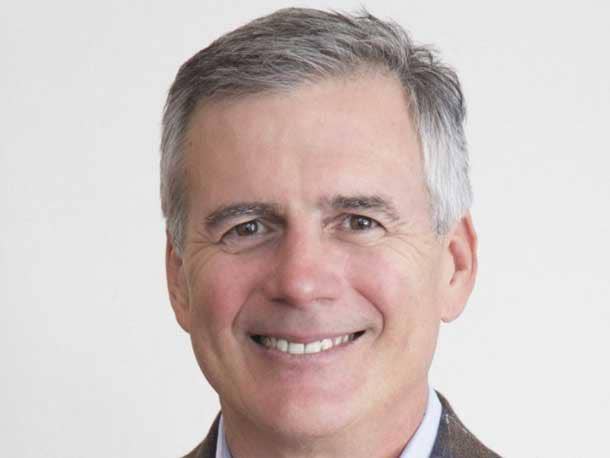TD Synnex CEO Rich Hume: Growth Despite Supply Chain, Talent Shortage
‘I think across just about every industry, and IT being part of it, there are some elevated attrition rates. But our expectation in our business is that there‘s nothing outside of the norm,’ says TD Synnex CEO Rich Hume.

Growth In A Rapidly Changing Distribution Business
In the six months since Synnex and Tech Data merged to form TD Synnex, the world’s largest IT distributor, the distribution business has seen rapid changes as the COVID-19 pandemic impact subsides, the “Great Resignation” of employees leaving to find better paying jobs goes on, supply chain shortages rise, and Russia goes to war with Ukraine.
Through all the changes, the IT industry has continued to flourish, which shows in TD Synnex’s fiscal 2022 first quarter financial report released Thursday. For the quarter, which ended February 28, the distributor reported revenue of $15.5 billion, up 1.5 percent compared to the two legacy distributors’ combined revenue for the same period a year ago. And while operating income for TD Synnex fell 12.0 percent over last year, non-GAAP operating income rose 13.9 percent and adjusted EBITDA rose 13.3 percent.
TD Synnex CEO Rich Hume told CRN the results were better than expected, not only for the quarter but for the first six months the new company has been operating, despite a competitive distribution environment. “When we look at the first six months of the merger and the combined company, the teams are executing quite well and serving customers and vendors in a very positive way,” Hume said. “So, a really good outcome, and we‘re proud of what we accomplished in the first six months of the combined company.”
Hume said supply chain issues, continued COVID-19 flare ups, and talented personnel shortages remain issues for TD Synnex. But they are issues impacting all companies in all industries giving a company like TD Synnex the opportunity to shine by managing them and still grow. “As we look into the future, we like the plays that we‘re running, and we believe that we’ll continue to bring good value to our customers and vendors,” he said.
There’s a lot of change happening in IT distribution, and TD Synnex is taking advantage of that change to continue growing its business. Here’s what Hume had to say.

Seems to be pretty good news on the financials front from TD Synnex today. Do a quick recap of the results.
Sure. So, when you take a look at our top line, our revenue had grown faster than we had anticipated, as did the bottom line overall. And we had a real good improvement in our earnings per share relative to expectations. And so, I think that when we look at the first six months of the merger and the combined company, the teams are executing quite well and serving customers and vendors in a very positive way. So, a really good outcome, and we‘re proud of what we accomplished in the first six months of the combined company.
Let's break this down a bit. First of all, why are revenue and earnings growing faster than expected? What's the impetus there?
When we look at the quarter in particular, the Advanced Solutions segment had stronger growth attributes than the endpoint part of the portfolio. I think that we fueled our growth with those products. Servers, storage, and networking are elements within that category overall. And it‘s not necessarily a surprise. We had a hypothesis that as we move through the year that the Advanced Solutions would provide pretty good growth attributes. If you think about the whole COVID period, people were generally remote and there was a lot of delays in project deployments. And now I think we’re starting to see them take hold.

So the Advanced Solutions segment is growing faster than TD Synnex’s endpoint business. What's going on with the endpoint business? Is there still growth there, and do you expect growth in the future?
I think there is a bit of a moderation [in endpoint growth], and it‘s consistent with what our thesis has been all of the time, and that is, through the work-from-home phase of the pandemic, et cetera, that there was a heightened demand. So last year there’s a bit of a harder compare. So we were expecting moderation. I would say that this isn‘t anything that we weren’t anticipating. And as we move through the year, we see that segment as moderating a bit while the Advanced Solutions segment would be where we would anticipate a bit more growth.
Are you expecting growth in the endpoint solution or not?
Overall for the year, yes, we would anticipate more moderate growth within that segment.

How are supply chain shortages impacting the different parts of TD Synnex?
If you take the top level, there‘s been marginal improvement within the overall backlog as we move through time. That being said, it’s a tale of two cities, where the backlog is actually improving in endpoint solutions or the PC ecosystem, just moderately. However, within the Advanced Solutions category, the backlog continues to grow, again, consistent with the hypothesis that we had for the market of this year. The backlog is sort of reflecting that same sentiment.
Do you expect any additional supply chain pressures going forward from the new wave of COVID hitting China, which seems to be disrupting some manufacturing there? Or do you expect that impact to be more limited?
I think if you roll back a week or two, there was a shutdown in Shenzhen, China, which is a major hub for IT production. They have recovered from that, and I think had gone back into production within one week‘s time. It’s very hard to predict these areas or regions that might have flare ups with COVID. But to the extent they occur and there are shutdowns, obviously that increases volatility within the supply chain. But it’s anyone‘s best guess as to how many of these flare ups we may or may not have and how prolonged they could be. But certainly, although there’s a bit more stability in the supply chain, these flare ups could create more instability. And that just sort of would add to those concerns. That being said, I don‘t believe anybody has the crystal ball to be able to project whether flare ups will be in regions that are particularly sensitive or where the IT supply chain is dependent upon.
So is TD Synnex exposed at all to Ukraine or Russia and the war going on there?
So, we historically, prior to the war, had very few, immaterial shipments into Russia on behalf of some customers. As we move forward, that has now been, for a period of time, been shut down, and we‘re making sure that we’re compliant relative to rule of law. But there would be no material impact to our business relative to the small amount of shipments that we historically have made into Russia.

Woman using a barcode reader in a distribution warehouse
Looking at the distribution business in general, how is TD Synnex doing compared to competition? Are you increasing market share? Is it more or less competitive going forward?
We‘re very comfortable relative to our position within the market. We have always had very formidable competitors, which we’ve got a lot of respect for, and we compete as we move through time. I don‘t believe there’s been any meaningful shifts at all relative to anyone‘s participation in the market. But as we look into the future, we like the plays that we’re running, and we believe that we‘ll continue to bring good value to our customers and vendors.
We seeing increased merger and acquisition activity among solution providers. Does that that impact how a distributor like TD Synnex interacts with channel partners?
What‘s important is that we have been receiving outstanding endorsement and support of both vendors and customers for our merger. I mean really, really strong sentiment relative to our relationships. That’s number one. Number two is, I think like any large and broad segment, we should expect that there‘s going to be industry consolidation. And by the way, I believe that industry consolidation is a good thing for parts of the channel because the capabilities and the ability to invest as you bring entities together becomes greater. And some of these transitions to new technology areas like security, cloud, IOT, and analytics really require more meaningful investment in order to be successful. And so, as we look at entities coming together, their ability to have more investment dollars to be successful in these new areas is strengthened. So, I think that consolidation as a generalization can be healthy and is something that we’re supportive of as those organizations that are heading down that path and working side by side with them to assist them to build more capabilities.

With the “great resignation” coming from employees finding it easier to find new opportunities outside their existing businesses and employers, how is this impacting TD Synnex? Are you seeing a big turnover in your employees? Are you finding it more easy or difficult to find the talent you need going forward?
I think across just about every industry, and IT being part of it, there are some elevated attrition rates. But our expectation in our business is that there‘s nothing outside of the norm. The way we combat this is to listen to our people, to understand, and listen to the industry as to how we fit in relative to the competitiveness of compensation packages and benefits, et cetera. So, we’re very focused on making sure that we provide a competitive package to all of our co-workers. And, so far, like everyone else, we‘ve been dealing with a little bit higher attrition, but nothing that is in the category of unmanageable, if you will.